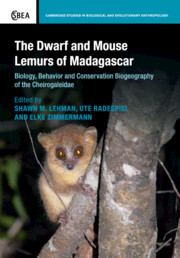Description
The Dwarf and Mouse Lemurs of Madagascar
Biology, Behavior and Conservation Biogeography of the Cheirogaleidae
Cambridge Studies in Biological and Evolutionary Anthropology Series
Coordinators: Lehman Shawn M., Radespiel Ute, Zimmermann Elke
The first ever reference book on the behaviour, physiology, conservation and biogeography of the dwarf and mouse lemurs of Madagascar.
Language: English
Subject for The Dwarf and Mouse Lemurs of Madagascar:
The Dwarf and Mouse Lemurs of Madagascar
Publication date: 06-2020
Support: Print on demand
Publication date: 06-2020
Support: Print on demand
The Dwarf and Mouse Lemurs of Madagascar
Publication date: 04-2016
570 p. · 17.8x25.3 cm · Hardback
Publication date: 04-2016
570 p. · 17.8x25.3 cm · Hardback
Description
/li>Contents
/li>Biography
/li>
The dwarf and mouse lemurs of Madagascar are two very species-rich lemur genera, yet there is a relative paucity of information on this primate family in published literature. In this first ever treatment of the Cheirogaleidae, international experts are brought together to review and integrate our current knowledge of the behaviour, physiology, ecology, genetics and biogeography of these species. A wide range of direct and indirect research methods that are currently used to study these cryptic nocturnal solitary foragers are described. By uniting often disparate research on captive and free-ranging taxa and synthesising recent methodological advances, this book provides new insights that will encourage further studies of this fascinating primate family. This synthesis will provide an incentive for more integrative studies of the Cheirogaleidae in captivity and in the wild, enabling the impacts of deforestation and other factors to be identified and directions for future conservation efforts to be established.
List of contributors; Foreword; Part I. Cheirogaleidae: Evolution, Taxonomy, and Genetics: 1. Cheirogaleid diversity and evolution: big questions about small primates; 2. The taxonomy of Cheirogaleidae: an ever expanding species list; 3. Mitogenomics of the family Cheirogaleidae and relationships to taxonomy and biogeography; 4. Why cheirogaleids are bad models of primate ancestors: a phylogenetic reconstruction; 5. Contact zones and species sympatry in dwarf lemurs (Genus Cheirogaleus): the roles of ecological adaptation and sexual selection; Part II. Methods for Studying Captive and Wild Cheirogaleids: 6. How to anesthetize mouse lemurs; 7. Microcebus murinus – a unique primate for modeling human brain disorders, including Alzheimer's disease and bovine spongiform encephalopathy; 8. Life history variation in mouse lemurs: the effect of environmental and phylogenetic determinants; 9. The effects of the lunar cycle, temperature, and rainfall on the trapping success of wild brown mouse lemurs (Microcebus rufus) in Ranomafana National Park, southeastern Madagascar; 10. Tiny samples from tiny lemurs: methodological considerations for endoparasite analyses in mouse lemurs; 11. A review of ectoparasites in the Cheirogaleidae; Part III. Cheirogaleidae: Behavior and Ecology: 12. Morphology, behaviour, ranging patterns and habitat use of the northern giant mouse lemur (Mirza zaza) in Sahamalaza, northwestern Madagascar; 13. Living in riverine and xeric forests: Microcebus griseorufus at Beza Mahafaly, SW Madagascar; 14. Determinants of intra- and interspecific isotopic variation in mouse lemurs from northwestern Madagascar; 15. Your food, my food: patterns of resource use in two sympatric mouse lemur species; 16. The physiology of phyletic dwarfism in Cheirogaleidae; 17. Possible causes and consequences of different hibernation patterns in Cheirogaleus species – Mitovy fatsy sahala; 18. Seed dispersal by mouse lemurs: Do Microcebus represent a unique frugivorous guild?; Part IV. Cheirogaleidae: Sensory Ecology, Communication, and Cognition: 18. Seed dispersal by mouse lemurs: do Microcebus represent a unique frugivorous guild?; 19. Predation in the dark: anti-predator strategies of Cheirogaleidae and other nocturnal primates; 20. The gray mouse lemur (Microcebus murinus): a novel cognitive primate brain aging model; 21. Acoustic divergence in communication of cheirogaleids with special emphasis to mouse lemurs; 22. Modeling the origins of primate sociality: social flexibility and kinship in mouse lemurs (Microcebus spp.); Part V. Cheirogaleidae: Conservation Biogeography: 23. Ecological niche modeling of mouse lemurs (Microcebus spp.) and its implications for their species diversity and biogeography; 24. Edge effects on tree dendrometrics, abiotics, and mouse lemur densities in western dry forests in Madagascar; 25. Factors determining Microcebus abundance in a fragmented landscape in Ankarafantsika National Park, Madagascar; 26. Can behavioural ecology help to understand the divergent range sizes of mouse lemurs?; 27. Conservation biology of the Cheirogaleidae: future research directions; Index.
Shawn M. Lehman is an Associate Professor in the Department of Anthropology at the University of Toronto. Specifically focusing on lemurs in Madagascar, his primary research objective is to integrate evolutionary ecology and conservation biogeography to model primate responses to anthropogenic disturbances.
Ute Radespiel is a Senior Lecturer at the Institute of Zoology, University of Veterinary Medicine Hannover, Germany. Her research centres upon determining the factors that drive and influence the evolution of social structures and lemur population dynamics at various spatial scales.
Elke Zimmermann is Professor and Chair of the Institute of Zoology at the University of Veterinary Medicine Hannover, Germany. Her research focuses on behavioural ecology with the aim of discovering the processes behind lemur adaptation and evolution.
Ute Radespiel is a Senior Lecturer at the Institute of Zoology, University of Veterinary Medicine Hannover, Germany. Her research centres upon determining the factors that drive and influence the evolution of social structures and lemur population dynamics at various spatial scales.
Elke Zimmermann is Professor and Chair of the Institute of Zoology at the University of Veterinary Medicine Hannover, Germany. Her research focuses on behavioural ecology with the aim of discovering the processes behind lemur adaptation and evolution.
© 2024 LAVOISIER S.A.S.




